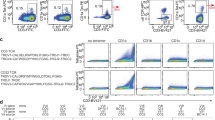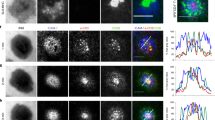Abstract
Naive T cell activation requires signaling by the T cell receptor and by nonclonotypic cell surface receptors. The most important costimulatory protein is the monovalent homodimer CD28, which interacts with CD80 and CD86 expressed on antigen-presenting cells. Here we present the crystal structure of a soluble form of CD28 in complex with the Fab fragment of a mitogenic antibody. Structural comparisons redefine the evolutionary relationships of CD28-related proteins, antigen receptors and adhesion molecules and account for the distinct ligand-binding and stoichiometric properties of CD28 and the related, inhibitory homodimer CTLA-4. Cryo-electron microscopy–based comparisons of complexes of CD28 with mitogenic and nonmitogenic antibodies place new constraints on models of antibody-induced receptor triggering. This work completes the initial structural characterization of the CD28–CTLA-4–CD80–CD86 signaling system.
This is a preview of subscription content, access via your institution
Access options
Subscribe to this journal
Receive 12 print issues and online access
$209.00 per year
only $17.42 per issue
Buy this article
- Purchase on Springer Link
- Instant access to full article PDF
Prices may be subject to local taxes which are calculated during checkout







Similar content being viewed by others
References
Lafferty, K.J., Misko, I.S. & Cooley, M.A. Allogeneic stimulation modulates the in vitro response of T cells to transplantation antigen. Nature 249, 275–276 (1974).
Riley, J.L. et al. Modulation of TCR-induced transcriptional profiles by ligation of CD28, ICOS, and CTLA-4 receptors. Proc. Natl. Acad. Sci. USA 99, 11790–11795 (2002).
Diehn, M. et al. Genomic expression programs and the integration of the CD28 costimulatory signal in T cell activation. Proc. Natl. Acad. Sci. USA 99, 11796–11801 (2002).
Acuto, O. & Michel, F. CD28-mediated co-stimulation: a quantitative support for TCR signalling. Nat. Rev. Immunol. 3, 939–951 (2003).
Wulfing, C. & Davis, M.M. A receptor/cytoskeletal movement triggered by costimulation during T cell activation. Science 282, 2266–2269 (1998).
Viola, A., Schroeder, S., Sakakibara, Y. & Lanzavecchia, A. T lymphocyte costimulation mediated by reorganization of membrane microdomains. Science 283, 680–682 (1999).
Boonen, G.J. et al. CD28 induces cell cycle progression by IL-2-independent down-regulation of p27kip1 expression in human peripheral T lymphocytes. Eur. J. Immunol. 29, 789–798 (1999).
Kovalev, G.I., Franklin, D.S., Coffield, V.M., Xiong, Y. & Su, L. An important role of CDK inhibitor p18(INK4c) in modulating antigen receptor-mediated T cell proliferation. J. Immunol. 167, 3285–3292 (2001).
Lindstein, T., June, C.H., Ledbetter, J.A., Stella, G. & Thompson, C.B. Regulation of lymphokine messenger RNA stability by a surface-mediated T cell activation pathway. Science 244, 339–343 (1989).
Boise, L.H. et al. CD28 costimulation can promote T cell survival by enhancing the expression of Bcl-XL. Immunity 3, 87–98 (1995).
Shahinian, A. et al. Differential T cell costimulatory requirements in CD28-deficient mice. Science 261, 609–612 (1993).
Green, J.M. et al. Absence of B7-dependent responses in CD28-deficient mice. Immunity 1, 501–508 (1994).
Lucas, P.J., Negishi, I., Nakayama, K., Fields, L.E. & Loh, D.Y. Naive CD28-deficient T cells can initiate but not sustain an in vitro antigen-specific immune response. J. Immunol. 154, 5757–5768 (1995).
Ferguson, S.E., Han, S., Kelsoe, G. & Thompson, C.B. CD28 is required for germinal center formation. J. Immunol. 156, 4576–4581 (1996).
King, C.L., Xianli, J., June, C.H., Abe, R. & Lee, K.P. CD28-deficient mice generate an impaired Th2 response to Schistosoma mansoni infection. Eur. J. Immunol. 26, 2448–2455 (1996).
Hutloff, A. et al. ICOS is an inducible T-cell co-stimulator structurally and functionally related to CD28. Nature 397, 263–266 (1999).
Krummel, M.F. & Allison, J.P. CD28 and CTLA-4 have opposing effects on the response of T cells to stimulation. J. Exp. Med. 182, 459–465 (1995).
Carreno, B.M. & Collins, M. The B7 family of ligands and its receptors: new pathways for costimulation and inhibition of immune responses. Annu. Rev. Immunol. 20, 29–53 (2002).
Yoshinaga, S.K. et al. T-cell co-stimulation through B7RP-1 and ICOS. Nature 402, 827–832 (1999).
Brodie, D. et al. LICOS, a primordial costimulatory ligand? Curr. Biol. 10, 333–336 (2000).
Bromley, S.K. et al. The immunological synapse and CD28–CD80 interactions. Nat. Immunol. 2, 1159–1166 (2001).
Davis, S.J. et al. The nature of molecular recognition by T cells. Nat. Immunol. 4, 217–224 (2003).
Ikemizu, S. et al. Structure and dimerization of a soluble form of B7–1. Immunity 12, 51–60 (2000).
Schwartz, J.C., Zhang, X., Fedorov, A.A., Nathenson, S.G. & Almo, S.C. Structural basis for co-stimulation by the human CTLA-4/B7–2 complex. Nature 410, 604–608 (2001).
Stamper, C.C. et al. Crystal structure of the B7–1/CTLA-4 complex that inhibits human immune responses. Nature 410, 608–611 (2001).
Collins, A.V. et al. The interaction properties of costimulatory molecules revisited. Immunity 17, 201–210 (2002).
Luhder, F. et al. Topological requirements and signaling properties of T cell-activating, anti-CD28 antibody superagonists. J. Exp. Med. 197, 955–966 (2003).
Metzler, W.J. et al. Solution structure of human CTLA-4 and delineation of a CD80/CD86 binding site conserved in CD28. Nat. Struct. Biol. 4, 527–531 (1997).
Holm, L. & Sander, C. Dali: a network tool for protein structure comparison. Trends Biochem. Sci. 20, 478–480 (1995).
Zhang, X. et al. Structural and functional analysis of the costimulatory receptor programmed death-1. Immunity 20, 337–347 (2004).
Peach, R.J. et al. Complementarity determining region 1 (CDR1)- and CDR3-analogous regions in CTLA-4 and CD28 determine the binding to B7–1. J. Exp. Med. 180, 2049–2058 (1994).
Sorensen, P. et al. Identification of protein-protein interfaces implicated in CD80–CD28 costimulatory signaling. J. Immunol. 172, 6803–6809 (2004).
Davies, D.R. & Cohen, G.H. Interactions of protein antigens with antibodies. Proc. Natl. Acad. Sci. USA 93, 7–12 (1996).
Bahadur, R.P., Chakrabarti, P., Rodier, F. & Janin, J. A dissection of specific and non-specific protein-protein interfaces. J. Mol. Biol. 336, 943–955 (2004).
Navaza, J., Lepault, J., Rey, F.A., Alvarez-Rua, C. & Borge, J. On the fitting of model electron densities into EM reconstructions: a reciprocal-space formulation. Acta Crystallogr. D Biol. Crystallogr. 58, 1820–1825 (2002).
O'Regan, M.N., Parsons, K.R., Tregaskes, C.A. & Young, J.R. A chicken homologue of the co-stimulating molecule CD80 which binds to mammalian CTLA-4. Immunogenetics 49, 68–71 (1999).
Margulies, D.H. CD28, costimulator or agonist receptor? J. Exp. Med. 197, 949–953 (2003).
Ostrov, D.A., Shi, W., Schwartz, J.C., Almo, S.C. & Nathenson, S.G. Structure of murine CTLA-4 and its role in modulating T cell responsiveness. Science 290, 816–819 (2000).
Davis, S.J. et al. Antibody and HIV-1 gp120 recognition of CD4 undermines the concept of mimicry between antibodies and receptors. Nature 358, 76–79 (1992).
Davis, S.J. & van der Merwe, P.A. The structure and ligand interactions of CD2: implications for T-cell function. Immunol. Today 17, 177–187 (1996).
van der Merwe, P.A., Davis, S.J., Shaw, A.S. & Dustin, M.L. Cytoskeletal polarization and redistribution of cell-surface molecules during T cell antigen recognition. Semin. Immunol. 12, 5–21 (2000).
Butters, T.D. et al. Effects of N-butyldeoxynojirimycin and the Lec3.2.8.1 mutant phenotype on N-glycan processing in Chinese hamster ovary cells: application to glycoprotein crystallization. Protein Sci. 8, 1696–1701 (1999).
Walter, T.S. et al. A procedure for setting up high-throughput, nanolitre crystallization experiments. I protocol, design and validation. J. Appl. Crystallogr. 36, 308–314 (2003).
Otwinowski, Z. & Minor, W. Processing of X-ray diffraction data collected in oscillation mode. Methods Enzymol. 276, 307–326 (1997).
Brunger, A.T. X-PLOR Version 3.1. A system for X-ray crystallography and NMR. (Yale University Press, New Haven, Connecticut, 1992).
Brunger, A.T. et al. Crystallography & NMR system: A new software suite for macromolecular structure determination. Acta Crystallogr. D Biol. Crystallogr. 54, 905–921 (1998).
Jones, T.A., Zou, J.Y., Cowan, S.W. & Kjeldgaard, M. Improved methods for binding protein models in electron density maps and the location of errors in these models. Acta Crystallogr. A 47, 110–119 (1991).
van Heel, M., Harauz, G., Orlova, E.V., Schmidt, R. & Schatz, M. A new generation of the IMAGIC image processing system. J. Struct. Biol. 116, 17–24 (1996).
Frank, J. et al. SPIDER and WEB: processing and visualization of images in 3D electron microscopy and related fields. J. Struct. Biol. 116, 190–199 (1996).
Grigorieff, N. Three-dimensional structure of bovine NADH:ubiquinone oxidoreductase (complex I) at 22 A in ice. J. Mol. Biol. 277, 1033–1046 (1998).
Stuart, D.I., Levine, M., Muirhead, H. & Stammers, D.K. Crystal structure of cat muscle pyruvate kinase at a resolution of 2.6 A. J. Mol. Biol. 134, 109–142 (1979).
Grimes, J.M. et al. The atomic structure of the bluetongue virus core. Nature 395, 470–478 (1998).
Gilbert, R.J. et al. Three-dimensional structures of translating ribosomes by Cryo-EM. Mol. Cell 14, 57–66 (2004).
Acknowledgements
The authors thank S. Ikemizu, E.Y. Jones, P.A. van der Merwe, K.M. Dennehy, S.H. Abidi and L. Hene for comments on the manuscript; and E. Mancini, J. Grimes and the staff of ID13 at ESRF for assistance with data collection. Supported by the Wellcome Trust, the Royal Society and the UK Medical Research Council through funding of the Oxford Protein Production Facility, and by Active Biotech Research AB.
Author information
Authors and Affiliations
Corresponding authors
Ethics declarations
Competing interests
T. Hanke and T. Hünig have a financial interest in TeGenero AG and antibody 5.11A1.
Supplementary information
Supplementary Fig. 1
Equilibrium analysis of monomeric sCD28 binding to sB7-1. (PDF 114 kb)
Supplementary Fig. 2
Final electron density maps for the CD28/511A1 Fab structure. (PDF 117 kb)
Supplementary Fig. 3
sB7-2d1 versus full-length sB7-2 binding to the CD28 homodimer. (PDF 128 kb)
Supplementary Fig. 4
Blocking the ligand binding site of CD28 with the 7.3B6 antibody. (PDF 119 kb)
Supplementary Table 1
Properties of major lattice contacts seen in crystals of costimulatory proteins. (PDF 32 kb)
Rights and permissions
About this article
Cite this article
Evans, E., Esnouf, R., Manso-Sancho, R. et al. Crystal structure of a soluble CD28-Fab complex. Nat Immunol 6, 271–279 (2005). https://doi.org/10.1038/ni1170
Received:
Accepted:
Published:
Issue Date:
DOI: https://doi.org/10.1038/ni1170
This article is cited by
-
sCD163, sCD28, sCD80, and sCTLA-4 as soluble marker candidates for detecting immunosenescence
Immunity & Ageing (2024)
-
The homodimer interfaces of costimulatory receptors B7 and CD28 control their engagement and pro-inflammatory signaling
Journal of Biomedical Science (2023)
-
The engineered CD80 variant fusion therapeutic davoceticept combines checkpoint antagonism with conditional CD28 costimulation for anti-tumor immunity
Nature Communications (2022)
-
Structural characterization of the ICOS/ICOS-L immune complex reveals high molecular mimicry by therapeutic antibodies
Nature Communications (2020)
-
Omega-3 polyunsaturated fatty acids: a promising approach for the management of oral lichen planus
Inflammation Research (2020)



